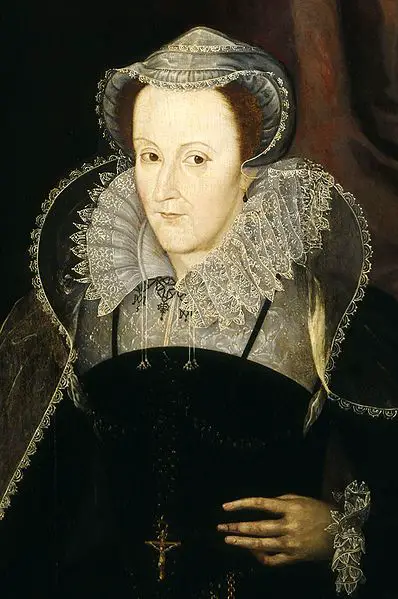 Following Catherine of Aragon's death on the afternoon of 7th January 1536, her body was prepared for burial by a chandler in her household, whose job it would have been to embalm her body. Sir Edmund Bedingfield and Sir Edward Chamberlain wrote to Thomas Cromwell from Kimbolton on 7th January about the arrangements they had made:
Following Catherine of Aragon's death on the afternoon of 7th January 1536, her body was prepared for burial by a chandler in her household, whose job it would have been to embalm her body. Sir Edmund Bedingfield and Sir Edward Chamberlain wrote to Thomas Cromwell from Kimbolton on 7th January about the arrangements they had made:
"Sir, the groom of the chandlery here can cere her [...] and further I shall send for a plumber, to close the body in lead, the which must needs shortly to be done." State Papers, King Henry VIII, Volume I,p452
"Cere" meaning to disembowel and embalm.
Eustace Chapuys, in a letter to Charles V on 21st January 1536, wrote of Catherine of Aragon's body being "opened" and examined following her death. She was not examined by a physician, but by a servant of her household, the chandler. It was usual for a chandler to embalm bodies ready for burial, but he would not have been a medical expert in any way.
Here is Chapuys' report:
"The Queen died two hours after midday, and eight hours afterwards she was opened by command of those who had charge of it on the part of the King, and no one was allowed to be present, not even her confessor or physician, but only the candle-maker of the house and one servant and a "compagnon," who opened her, and although it was not their business, and they were no surgeons, yet they have often done such a duty, at least the principal, who on coming out told the bishop of Llandaff, her confessor, but in great secrecy as a thing which would cost his life, that he had found the body and all the internal organs as sound as possible except the heart, which was quite black and hideous, and even after he had washed it three times it did not change color. He divided it through the middle and found the interior of the same color, which also would not change on being washed, and also some black round thing which clung closely to the outside of the heart. On my man asking the physician if she had died of poison he replied that the thing was too evident by what had been said to the Bishop her confessor, and if that had not been disclosed the thing was sufficiently clear from the report and circumstances of the illness." LP x. 141
The description of the heart gave rise to the idea that Catherine had been poisoned, particularly as her illness had been said to worsen after drinking a draught of Welsh ale:
"The Queen's illness began about five weeks ago, as I then wrote to your Majesty, and the attack was renewed on the morrow of Christmas day. It was a pain in the stomach, so violent that she could retain no food. I asked her physician [de la Soa] several times if there was any suspicion of poison. He said he was afraid it was so, for after she had drunk some Welsh beer she had been worse, and that it must have been a slow and subtle poison for he could not discover evidences of simple and pure poison; but on opening her, indications will be seen." Chapuys to Charles V, 9 January 1536, LP x. 59
Chapuys and Miguel de la Soa, Catherine's physician were convinced that Catherine had been poisoned.
However, as Giles Tremlett and Patrick Williams point out in their biographies of Catherine, the description of the heart actually suggests cancer:
"A secondary melanotic sarcoma was almost certainly to blame." Giles Tremlett (Afterword, Catherine of Aragon: Henry's Spanish Queen)
"...if this unscientific analysis has any relevance it would suggest that Katharine died of a cancerous metastatic melanoma." Patrick Williams, Katharine of Aragon, p375. In his notes, Williams thanks Dr Veronica Sprott for her advice.
J.J. Scarisbrick, in his book "Henry VIII", also wrote that the chandler's description "is conclusive evidence that she died of cancer. His description of the 'black round body' and her blackened heart exactly fits that of a secondary melanotic sarcoma." (p334) Scarisbricj cites Sir Arthur Salisbury MacNalty's "The Death of Queen Catherine of Aragon", Nursing Mirror, 28 December 1962, but I have been unable to find a copy of MacNalty's article.
Antonia Fraser (The Six Wives of Henry VIII, p282) writes of how Sir Norman Moore, demonstrator of morbid anatomy at St Bartholomew's Hospital, and later President of the Royal Physicians, put Catherine's death down to melanotic sarcoma, the tumour on her heart being a secondary one and the chandler "having missed the primary growth". Moore discussed this in "The Death of Catherine of Aragon", The Athenaeum, 1885.
Although the chandler's findings meant that Catherine's loyal supporters could spread rumours of poison and murder, modern medical experts do not believe that the findings support this idea at all. Catherine died of natural causes, of cancer. Antonia Fraser writes of how it is "fanciful" and "romantic" to think that Catherine died of a broken heart, but "Nevertheless one notes that when Queen Catherine died, it was her heart that was most visibly affected. And that seems symbolic at least, if the connection is not medically sound." Whatever the actual cause of her death, Catherine was definitely nursing a broken heart.



I remember as a young girl reading about the black growth on Katherine’s heart and having a romantic idea about Katherine having a broken heart. But working in a hospital and your factual information on the subject , makes a lot of sense to me , and makes Katherine seem real, not just a person who lived years ago. Hope you can make sense of what I’m trying to say ?
I understand Lynne. To be honest the “Broken Heart” idea may sound romantic in some ways, but to be honest I believe that in some modern cases of a husband/wife dying within a month of their partners death it could be argued that, they did indeed die of a broken heart. When I lived up north, there was an elderly couple in sheltered accomdation who lived over, the road from me. They were childhood sweethearts and completely devoted to each other. One afternoon, her husband had a fall, it wasnt a bad fall as such, but he had hit his head as he had fallen, within days he was dead.
Naturally she was devestated, when the warden came around the next morning, she found the elderly lady dead in her armchair. Of course there was the usual panic and the whys and wherefores. The post mortum showed apsolutely nothing wrong which would cause to just die so suddenly.
But I do feel that it was a broken heart, she just simply couldn’t bear the thought of facing life without him, and simply gave up. Their son made sure that they would always be together too as he had them buried together too.
I find these deaths although very sad, also very moving in the sence that the devotion they felt for each other during life goes beyond life. I hope that makes sence.
Now as for Katherine, certainly I think a lot of her health issues stemmed from the time of her long widow/engagement hood, before Lard Arse took the throne. Added with her continued pregnancies, it didn’t really help matters much, her body was never really given the chance to recover from the last stillbirth/miscarriage, befor she had to start all over again.
I also think that up until the last few months of her life she truly believed that Lard Arse was simply suffering from some sort of mid-life psychotic episode, and that once he realised the folly of his actions, he would come back to her. Elizabeth’s birth had perhaps, fueled that hope. But when she realised that Lard Arse was not going to come back to her crown in hand, she didn’t give up exactly, but decided to try and make him remember the happy times they had had when they first married, in a hope that perhaps he would treat her with a little more kindness. Sadly as far as Lard Arse was concerned she was like his dead brother/father before him. Nothing. She died a long time ago, along with a long forgotten brother, in a cold castle on the Welsh Marches on a cold April day.
I believe her death was nothing more than what was reported she had a cancer of the heart. If she had suffered some sort of heart attack at some point during her last hours, it’s highly possible that the reason for the colour of her heart being black, was that blood had seeped into the surrounding tissues, in short her heart was bruised.
What I find ironic in all this, is that for 10 long years, Katherine tried to make Lard Arse see reason, and make him realise the folly of his actions, both to her and to God, but he shut his ears to her pleading. But when he read her last letter all hell broke loose, within months, Anne was dead along with many others, he had remarried, and Lard Arse’s manic mashinations had gone into overdrive. We all know what was said in that letter. It looks a fairly normal sort of letter, she tells him she still loves him, and that she forgives his sins against her, etc..but I think that there is a hidden message in it that was something only known between them, and whatever that message was, no one will ever know. I do feel though that Katherine’s death affected Lard Arse more than anyone actually realised. Katherine had been a lard part of his life. The fact that he lived just over 10 years from her death says it all in those 10 years, he’s chopped up 2 wives, became a widower, divorced another, and made his last wife breathe a sigh of relief that she had actually survived.
He had been married to Katherine for over 20 years, but he had know her since he was 10, so all in all they had shared a lifetime and then some together.